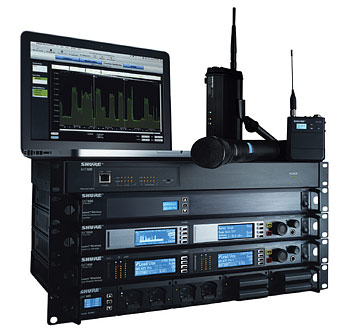Intercom Users Cope With Spectrum Squeeze
SEATTLE: When you watch one of those special forces movies, where the team is somewhere remote overseas, and each team member has an earpiece so they can talk to the command center somewhere in America, it would seem like wireless intercom systems for a television production venue would be a piece of cake.
But the licensed spectrum available for traditional wireless intercom systems, the UHF band, has been shrinking, while at the same time there are more and more users. Therefore, wireless intercom suppliers are exploring other, unlicensed spectrum, higher up the frequency ladder.

Riedel Acrobat wireless beltpack intercom Leaving the UHF band is not popular, noted Vinnie Macri, product marketing manager at Clear-Com. "The lower you go in UHF frequencies, the bigger the waves are, the more it goes around buildings, through concrete walls, under doorways. And the higher you go in frequencies, the wavelengths are very close together, very short wavelengths, and they're not as penetrating."
But there's little choice. With the auctioning of UHF frequencies that's already taken place to commercial interests such as cellular networks, and future auctions in the offing, the availability of UHF spectrum for television and entertainment venues use is shrinking. In transitioning to DTV transmission, there's also the loss of spaces that used to keep a broadcast television channel's audio from interfering with that channel's video, a place where wireless intercoms (and wireless mics) could "slot" into.
NOT JUST A U.S. PROBLEM
This shrinking spectrum phenomenon may seem like an American thing, but it's spreading worldwide according to Andreas Hilmer, director for marketing and communications at Riedel in Germany. "In Europe there's a situation [where governments need money], and they're auctioning some frequencies that were formally used for wireless microphones, for wireless intercoms, for additional TV channels." They're also getting ready for their own DTV transition.
"We have other types of technologies and bands out there that we can possibly get into to get around this issue," said Larry Benedict, product manager for wireless intercoms, radio dispatch, and antennas at Bosch Security Systems, parent of the Telex and RTS intercom brands. For instance, moving from analog to digital wireless systems can allow wireless intercoms (and wireless microphones) to operate closer together, frequency-wise.
He also pointed out one saving grace of intercom applications: "Wireless intercom is not as audio quality-demanding as, say, a wireless microphone application." This opens up more options.

Clear-com’s HME DX210 2-channel wireless systems makes it possible for the North Carolina Shakespeare Festival production team to have multiple talk paths and untethered communication for theatre production. Among those options are the 900 MHz band and the 1.8 to 1.9 GHz band, commonly referred to as the DECT band (cordless phones, baby monitors, etc.), and the 2.4 GHz band, which is the home of WiFi. Wireless intercom system builders are using digital technologies such as frequency hopping, where the transmitter and receiver move quickly from one piece of spectrum to another.
Clear-Com's Macri pointed out that while one might think such frequency hopping would interfere with a WiFi network in or close to a particular venue, "they never see it because it's only there for 200 milliseconds."
What works in one location will not necessarily be a successful solution in another, said Bosch's Benedict. "The spectrum challenge that you encounter in each location is different. And so what works in Minneapolis on a Friday night, might not work in Dallas on a Monday night."
For touring shows, like mega-concert rock bands, this presents a new problem in each city. But the frequency coordination headaches for events like the Super Bowl are also legion.
CONDUCT A FREQUENCY SURVEY
But any venue anywhere can have its own unique spectrum challenges. One vendor told the story of a house of worship which tried the DECT band unsuccessfully, only to discover that the Sprint cellular phone site, housed in rented space in the church's own steeple, was causing interference. The advice from all wireless microphone vendors was consistent: hire a professional to do a frequency study on the site. A site-specific source of interference, as invisible as a power grid monitoring radio on a nearby street light pole, can easily turn up.
That survey should precede a shopping trip for wireless intercom equipment, said Riedel's Hilmer. "There's not a single solution that fits to all the applications. And that's why there are so many, many different sets around. In many applications, none of the wireless intercoms are able to fill all the requirements."
Finally, in the "it's always something" category, one advance in television imaging, CMOS sensors in television cameras, may also limit the use of wireless intercoms by camera operators, according to Johannes G. Rietschel, CEO and founder of based Barix AG, an intercom maker based in Switzerland. "Any sort of RF can cause interference with HD CMOS sensors."
So the landscape in which wireless intercom systems operate looks to continue to be a moving feast, with new challenges, expected and unexpected, just around the corner.
The professional video industry's #1 source for news, trends and product and tech information. Sign up below.
